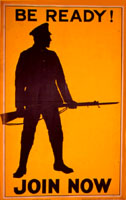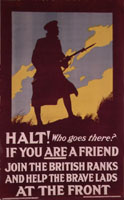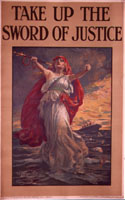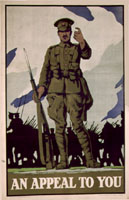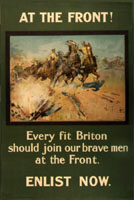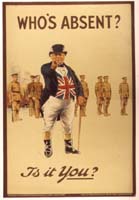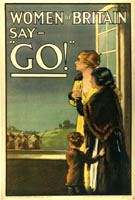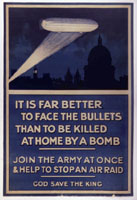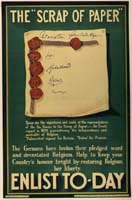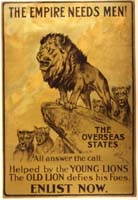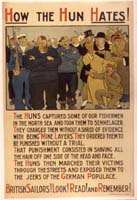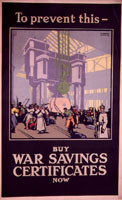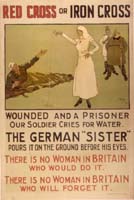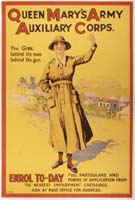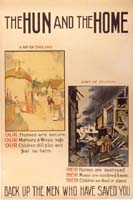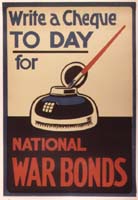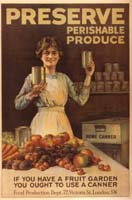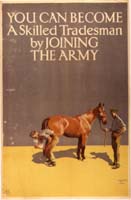Introduction
The Roger N. Mohovich Collection contains, counting duplicates, rather more than 400 posters created during the First World War or very shortly afterwards. Well over 300 of the posters are American, as is only to be expected; of the remainder, some 50 are of British origin. These British posters are by no means so well known in this country as many of the American ones, and it is hoped that awareness of them will be increased by means of this exhibition—and particularly its installation as part of the library’s web site. The 25 examples selected, although they include examples by neither of the best-known British war poster artists, Frank Brangwyn and G. Spencer Pryse, display most, if not all, of the stylistic and thematic ideas which typify British poster art during the war.
There is little need here to repeat in miniature the history of First World War posters; interested readers or viewers are urged to consult the texts by Martin Hardie and Arthur K. Sabin (War Posters, London: A. & C. Black, 1920) and Maurice Rickards (Posters of the First World War, New York: Walker, 1968). The roughly chronological arrangement of the posters in the exhibition reveals the initial concern with recruiting, followed as the war dragged on by no less necessary demands on the civilian economy and a need to blacken utterly the character of “the Hun.” The single post-war example shown demonstrates a far different approach to recruiting, if perhaps one that relies overly on the continued viability of a horse-drawn economy. Posters illustrated in the books by Hardie/Sabin and Rickards are so noted in the brief descriptive entries for each work.
Some details concerning the production of the posters may, however, be of interest. In a number of cases, particularly in works prepared under the auspices of the Parliamentary Recruiting Committee, the printer’s information line at the bottom of the poster proves to be quite revealing. The number of copies printed of these relatively early posters was fairly large. Most of them were done in 10,000 copies (given generally as “10M” on the poster itself); the Bernard Partridge poster which provides the title for the exhibition was done in an edition of 25,000. Many of the later posters lack statements regarding edition size, but the anonymous “Write a Cheque To Day” was printed for the National War Savings Committee in January, 1918, in a nominal run of 100,000. Printing dates are commonly given in an abbreviated “month/year” (e.g., “1/18”) form. Most of the printing work was done, of course, in or near London, but as the demand for posters multiplied an increasing amount of work was given to “provincial” printers, as the imprints of Belfast, Bristol, Newcastle-on-Tyne, and Abergavenny included in the exhibition will attest.
Not a great deal is known about the artists who created these posters—or at least their central images, for much of the lettering and layout would have been the province of the expert lithographers whose commercial training prepared them for the task. Sir Bernard Partridge achieved considerable fame as a cartoonist for Punch; the unsigned “Who Follows?” shows a strong stylistic resemblance to some of Partridge’s magazine work during the war years. Arthur Wardle, the creator of “The Empire Needs Men!” was widely known as an animal painter, as the poster clearly reveals; so too, judging from the examples shown, must have been the artist hidden behind the initials “T. E.” For the other artists tracked down so far as to determine their dates, little specific information has turned up.
The Mohovich Collection was acquired in 1997 as a gift from Mr. Mohovich’s heirs, David van Buskirk and Warren Wilson. To them, as well as to the executor of the estate, Michael C. Lang, and a good friend of the library who located the collection and urged its presentation to Georgetown, we owe a considerable debt of gratitude.
Entries for each poster are arranged in the following format: artist; title; publisher; date; printer; size (in inches, height before width); series number; edition size; and references. Not all information can be determined for all of the posters, and the inferred dates, indicated by a question mark following the year given, represent no more than the opinion of the cataloger.
George M. Barringer
Assistant University Librarian, Special Collections and Archives
Be Ready! Join Now
Anonymous artist
Harrow: David Allen & Sons, Ltd.
July 1915
38 3/4 x 24 1/2
Parliamentary Recruiting Committee, London
Halt! Who goes there?
Anonymous artist
London: Hill, Siffken & Co.
April 1915
38 1/2 x 24
Parliamentary Recruiting Committee, London
Take Up the Sword of Justice
Partridge, Sir Bernard, 1861-1945
Harrow: David Allen & Sons, Ltd.
June 1915
39 3/4 x 24 1/2
Parliamentary Recruiting Committee, London
Reference: Hardie & Sabin, 2
An Appeal to You
Anonymous artist
London: Roberts & Leete, Ltd.
April 1915 or later
38 1/2 x 24 1/2
Parliamentary Recruiting Committee, London
Reference: Rickards, 12
Come into the ranks
Anonymous artist
London: Roberts & Leete, Ltd.
March 1915 or later
37 1/4 x 24 1/2
Parliamentary Recruiting Committee, London
At the Front!
E., T.
Bristol: E. S. & A. Robinson, Ltd.
April 1915 or later
29 3/4 x 19 3/4
Parliamentary Recruiting Committee, London
Reference: Rickards, 87
Who's Absent?
Anonymous artist
Newcastle-on-Tyne: Andrew Reid & Co., Ltd.
September 1915
29 1/4 X 19 3/4
Parliamentary Recruiting Committee, London
Reference: Rickards, 11
There's Room for You
Fry, W. A.
Belfast and London: Wm. Strain & Sons, Ltd.
August 1915
29 1/2 x 19 3/4
Parliamentary Recruiting Committee, London
Women of Britain Say - 'Go!'
Kealey, E. V.
London: Hill, Siffken & Co.
May 1915
29 1/2 x 19 3/4
Parliamentary Recruiting Committee, London
Reference: Rickards, 40
It is far better to face the bullets
Anonymous artist
Newcastle-on-Tyne: Andrew Reid & Co., Ltd.
February 1915 or later
29 x 19 1/2
Publicity Department, Central Recruiting Depot
Reference: Rickards, 15
The Key to the Situation
Anonymous artist
London and Abergavenny: Seargeant Bros., Ltd.
July 1915
29 x 19
Parliamentary Recruiting Committee, London
The "Scrap of Paper"
Anonymous artist
London: Johnson, Riddle & Co., Ltd.
December 1914
28 3/4 x 18 3/4
Parliamentary Recruiting Committee, London
The Empire Needs Men!
Wardle, Arthur, 1864-1949
London: Straker Brothers, Ltd.
March 1915
29 1/4 x 19 3/4
Parliamentary Recruiting Committee, London
Germany means to starve us out
Scott, Septimus Edwin, b. 1879
Publisher not given; Printer not given
1917
29 1/4 x 19 1/4
How the Hun Hates!
Wilson, David, 1873-1934
London: Dangerfield Printing Co., Ltd.
1917?
29 1/2 x 19 1/2
Red Cross or Iron Cross
Wilson, David, 1873-1934
London: Dangerfield Printing Co., Ltd.
1917?
29 3/4 x 19 3/4
God Speed the Plough and the Woman Who Drives It
Gawthorn, Henry George, 1879-1941
London: David Allen & Sons, Ltd.
1917
29 3/4 x 20
Reference: Rickards, 237 (listed erroneously under "USA")
The Hun and the Home
Wilson, David, 1873-1934
London: Dangerfield Printing Co., Ltd.
1918?
29 3/4 x 19 3/4
Write a Cheque To Day
Anonymous artist
H. H., Ltd.
January 1918
28 3/4 x 19 1/2
National War Savings Committee, London
If for every one in the Kingdom a piece of Coal
Anonymous artist
London: Haycock-Cadle Co.
1918?
29 3/4 x 19 3/4
Coal Mines Department Board of Trade
Preserve Perishable Produce
Food Production Department, London

